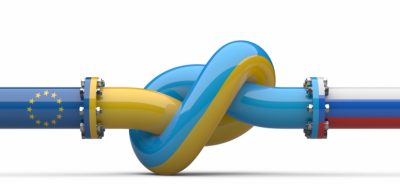Ukraine Eyes America for Gas but Still Relies on Russia

Despite strong attempts by Ukraine not to buy Russian pipeline gas, they will not be able to receive U.S. liquefied natural gas (LNG) for at least another five years according to Polish experts from the consulting company ESPERIS. According to the agreement between the U.S. and Ukraine signed in March, the U.S. will sell 6-8 million cubic meters.
The Polish experts say that despite the fact that Ukraine stopped the official importation of Russian gas in 2015, it does not have independence from fuel produced in Russia, since in reality Russian gas still reaches Ukraine via the European Union countries of Slovakia, Hungary and Poland.
The Polish experts explain that “By the end of 2019, all the natural gas imported into Ukraine from the EU was shipped via physical reverse from the direction of Slovakia (since 2016 average 8.7 bcma), Hungary (average 2.7 bcma) and Poland (average 1.1 bcma).”
Physical reverse means that effectively Slovakia, Hungary and Poland will buy gas from Russia then reverse its flow into Ukraine. Through this way Ukraine is not buying Russian gas while receiving Russian gas through other means. The ironic part is that as the ESPERIS report explains,
“Natural gas imported from the European suppliers, such as DXT, RWE or PGNiG, is in fact mostly produced in Russia and then sent via Ukraine to EU. Thus, the ultimate independence of Ukraine from the Russian supplies can be reached only by opening of a new source of supply.”
The problem is that Ukraine does not have its own LNG regasification means. The report explains that
“the Ukrainians tried to build LNG importing terminal in Odessa or Ochakiv for several years, but as for now the project seems to be dead at all.”
Romanian LNG terminals may not be possible as Turkey may refuse tankers with raw and highly explosive materials to pass through the Bosporus. The route through Croatia is not profitable due to transit fees and transportation costs.
Therefore, the only realistic port of delivery available for Ukraine would be at the Swinoujscie regasification terminal in Poland. However, Swinoujscie’s capacity for Ukraine is not enough. Ukraine will be able to receive U.S. gas only through Poland, where the floating regasification terminal is planned to be launched in Gdansk, but these deliveries cannot begin before 2025 and only if the Polish side is ready to invest large amounts of money in this construction.
Warsaw advocates the construction of a new pipeline between the gas transmission systems of Poland and Ukraine. However, the Polish report explains that this project requires large expenditures on the part of Kiev and therefore remains frozen as it cannot afford to do it.
Despite the reality that Ukraine is entirely reliant on Russian gas, on April 8 the head of Ukraine’s new gas transit system operator Sergey Makogon declared that the country was ready for zero gas transit from Russia despite not having the means to do so. On January 31, it was reported that the transit of Russian gas through Ukraine since the beginning of that month had increased its price by 2% and could cost more than $7 billion in five years. According to RBC, the total volume of traffic for five years will be 225,000 million cubic meters and the pumping cost will be $31.72 per 1,000 cubic meters, including all taxes and fees.
On December 31, 2019, it was reported that Gazprom and the Ukrainian operator signed a transit agreement for Russian has to reach Europe. According to the document, in 2020, 65,000 million cubic meters of Russian gas will pass through Ukraine. Then, until 2024, annual deliveries will drop to 40 billion cubic meters. Although Ukraine will become a transit country, it somehow also does not want to use Russian gas for its own domestic consumption.
Russia has the largest reserves of gas in the world and in the future the consumption of natural gas will grow because coal and oil consumption will be reduced. In 2018 alone, Gazprom, Russia’s largest gas company, supplied the European Union with more than 40% of its natural gas imports. Although Ukraine is working towards independence from Russian gas, it is in the vague hope that this move will somehow allow the country to move closer to the European Union despite most of the continent relying on and using Russian gas.
The Polish report concluded that “Without the upgrade of pipelines and import terminals in the region neither Ukrainian energy independence nor U.S. LNG export to Ukraine will develop.” Effectively, as Ukraine has the ambition to become “energy independent” from Russia, it has neither the finances or infrastructure to achieve this.
*
Note to readers: please click the share buttons above or below. Forward this article to your email lists. Crosspost on your blog site, internet forums. etc.
This article was originally published on InfoBrics.
Paul Antonopoulos is a Research Fellow at the Center for Syncretic Studies.
Featured image is from InfoBrics

